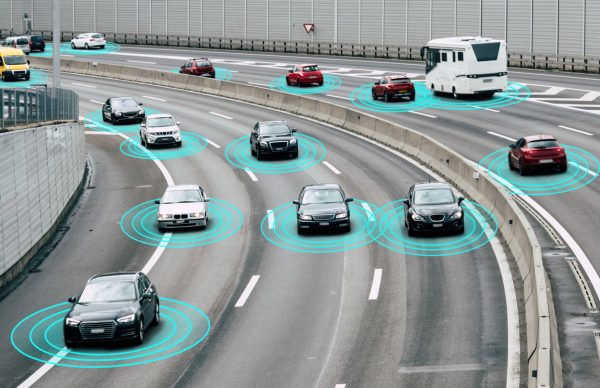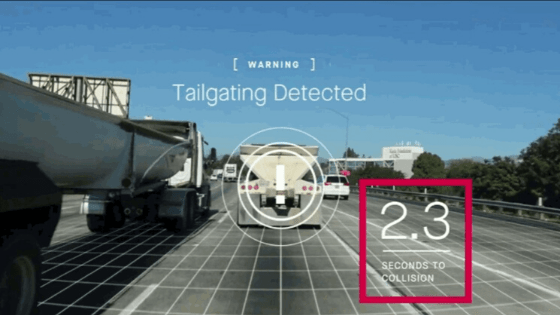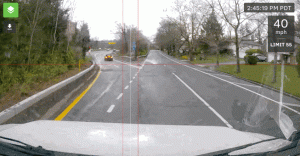With an estimated 3,700 people killed in car accidents every day, it’s little wonder that vehicle safety features are such a hot-button topic for car manufacturers and consumers alike.
Advanced driver-assistance systems (ADAS) are quickly becoming the gold standard in new vehicles, and the features that come with them can drastically improve driver and vehicle safety.
Let’s look at the top eight ways ADAS improve vehicle safety.
1) Blind Spot Detection
Blind spot detection uses sensors to detect vehicles in areas of the road just outside of the driver’s field of vision that can’t be easily viewed in the rear-view mirrors or windows. In these instances, ADAS would warn you through lights and sounds when another vehicle is present but not necessarily visible.
The system also warns you when there are pedestrians or cyclists near your car so that you can avoid an accident.
2) Lane Departure Warning
A lane departure warning system (LDWS) is an active safety technology designed to warn a driver if they inadvertently veer out of their lane on the road. The system uses cameras or other sensors to track a vehicle’s position; if it senses that the car is crossing a line, an alert is triggered.
LDWS systems are considered an “active” safety feature, which means they take immediate action in some way when required, versus passive systems such as airbags, which only deploy when triggered by a crash.
Because LDWS is classified as an active safety feature, it can provide drivers with potentially life-saving alerts when traveling at high speeds on busy roads.
3) Advanced Cruise Control
Vehicles equipped with an advanced cruise control system will ensure your drivers maintain a safe distance from other cars on the road.
The best ADAS systems aren’t just meant for highway driving. They should also be employed when navigating through stop-and-go traffic to heighten awareness of upcoming stop signs and traffic lights, as well as cars around you when pulling out into an intersection or turning at an intersection.
4) Pedestrian Protection Systems
Injuries sustained by pedestrians account for almost half of all traffic-related deaths worldwide. For this reason, many manufacturers are outfitting their vehicles with pedestrian protection systems to reduce the risk of injury if a pedestrian is hit by a vehicle, or help avoid accidents altogether.
The system works as soon as a sensor detects an imminent collision and initiates an automatic braking command to minimize or prevent any impact between car and pedestrian.
The system also works in reverse. In the event of a potential rear impact, it will trigger another sequence of events – warning lights and sounds alerting the driver to upcoming impact – potentially avoiding rear-end collisions altogether.
5) Automatic Emergency Braking (AEB)
AEB prevents or mitigates front-to-rear impact by stopping a vehicle if an imminent collision is detected. AEB systems can be activated via Forward Collision Warning (FCW) and Lane Departure Warning (LDW).
It’s also common for AEB to work with adaptive cruise control, which automatically slows a vehicle down when another car is detected. Some advanced versions of AEB can steer vehicles out of danger autonomously.
6) Parking Assistance Systems
Parking assistance systems are among the most basic forms of ADAS. They include automatic sensors that help guide a vehicle into a parking spot, and cameras that automatically detect other vehicles or obstacles while parking.
These features can help prevent driver error when parking- one of the most common causes for collisions. These systems sometimes come with sensor warnings when approaching objects in front or on both sides of your vehicle.
7) Driver Drowsiness Monitoring System (DDMS)
Many vehicles already have or are developing systems that monitor drivers’ eyes to help detect drowsiness.
The system uses infrared lights positioned on, near, or in front of a car’s rearview mirror(s) and camera(s) to analyze blinking, eye position, and driver response to determine whether they are tired.
If it looks like a driver needs some rest, the vehicle produces visual and/or audio triggers until the driver regained alertness.
Many manufacturers now offer hands-free features for their infotainment systems, enabling drivers to always keep both hands on the wheel and their eyes on the road.
8) Traffic Sign Recognition System
If you’re driving in an unfamiliar city, traffic sign recognition systems can be a lifesaver. These systems automatically detect speed limit signs and display that information in your instrument cluster.

Other Benefits of ADAS
As impressive as these benefits are, it’s important to remember that there are many other ways that ADAS technologies improve vehicle safety. Here’s a quick rundown of some additional features and benefits of these systems:
- Traction control-equipped vehicles are more efficient on slippery roads. While you may think that traction control is only helpful in poor weather conditions, like snow and ice, it’s a valuable feature even on ordinary days in slick terrain.Traction control delegates optimal power to each wheel to keep your vehicle as stable as possible while driving at high speeds in slippery conditions. Additionally, traction-control technology can help drivers avoid swerving, which prevents accidents and maintains safety while driving on typical roadways.
- Tire pressure monitoring systems are essential to improve safety on both new and old vehicles. Drivers with older vehicles without these systems often have incorrect tire pressure, leading to poor vehicle handling and poor fuel efficiency.With these devices installed in your car, you can make sure that your tires are properly inflated at all times.
- Mapping solutions help drivers get to their destinations efficiently and safely. Mapping systems always provide your location, allowing you to make informed decisions about your route and keeping you on track towards your destination.Some advanced navigation devices will even re-route you if there’s an accident along your route, ensuring that safety is always a priority on the road.
The Bottom Line
As technology continues to advance, so will vehicle safety. From automatic emergency brakes to collision-avoidance systems and more, there are plenty of features available on vehicles today that would have seemed like science fiction just a few years ago.
While we have come a long way in terms of road safety over time, there is still room for improvement when considering driver and passenger protection. Contact your GoFleet consultant for a full list of our ADAS features, and let us help you make your fleet safer for your drivers and your business.








